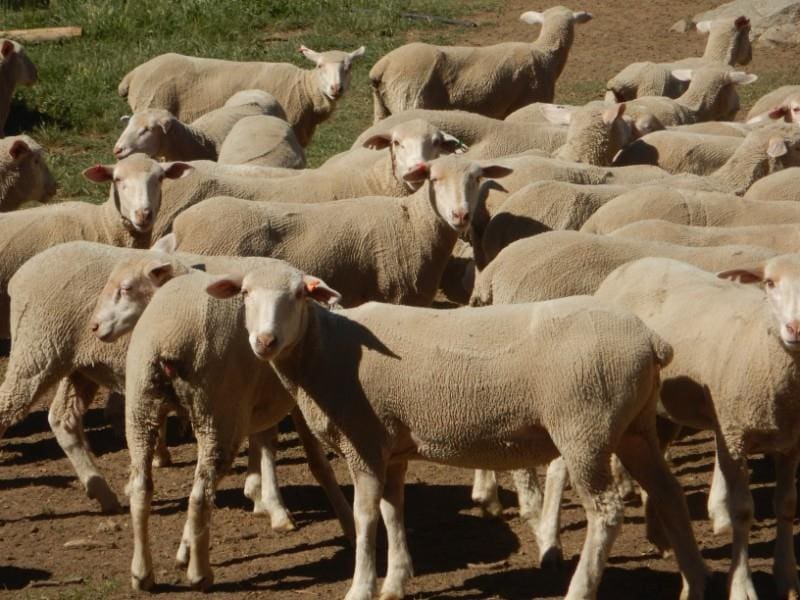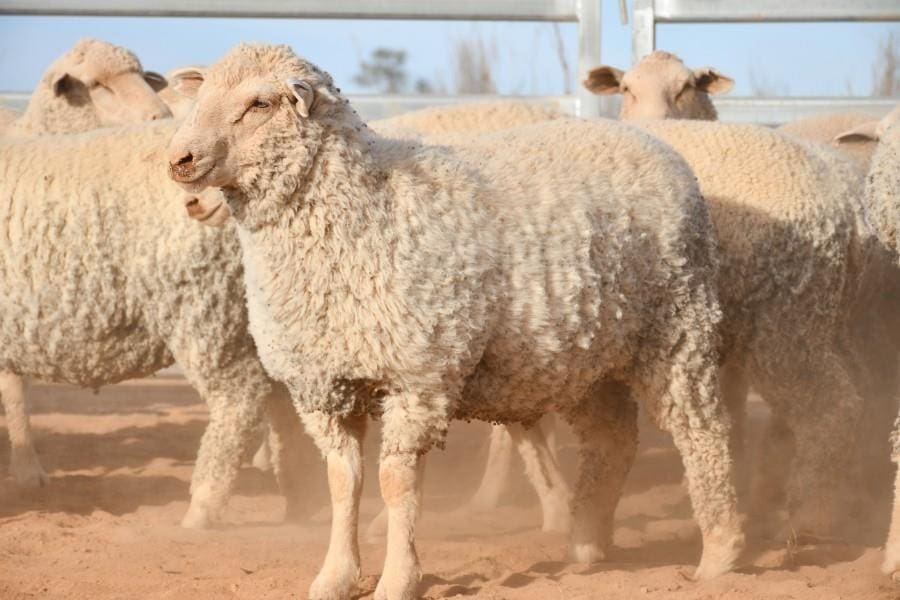
These 49kg White Suffolk-Merino cross ewes at Cooma in NSW sold for $245 on AuctionsPlus this week.
SHEEP producers are retaining the ewe portions of prime lamb drafts as replacement breeders or to supply keen restockers, as ewe prices remain high.
High lamb and mutton prices, and post-drought restocking demand helped drive ewe prices to record heights in 2020 – up to $650 for Australian Whites, to $476 for joined first cross ewes, $472 for unjoined ewes and to $624 for ewes with lambs.
And although ewe prices might have come back from the Spring peaks, the latest industry figures and selling behaviour indicate the demand for ewes is unsatisfied and is expected to continue next year.
The October results of the Meat & Livestock Australia and Australian Wool Innovation Wool and Sheepmeat Survey showed that 42 percent of respondents intend to increase their ewe flocks in the next 12 months. More than half of the producers (52pc) said they intended to maintain numbers and 7pc will drop sheep numbers.
The survey, which is run three times a year, had 1678 participants across 2495 different properties. It showed that most producers (54pc) would retain more replacement ewes than normal, with 44pc retaining more older ewes than normal and 34pc purchasing more ewes.
White Suffolk cross ewe lambs making a premium

These 44kg White Suffolk-Merino cross ewe lambs sold for $169 at Cobar were among many sold as future prime lamb breeders this year.
Nutrien Cobar agent Luke Scales this week sold 390 June-July drop White Suffolk-East Bungaree Merino cross ewe lambs weighing an average 44kgs for $169 for the Blore Pastoral Trust at Comarto Station, Wilcannia, on AuctionsPlus to a prime lamb breeder. White Suffolk cross ewe lambs sold for up to $245 in the online sale.
He said it was the first time the client had sold second cross ewe lambs separately rather than as part of a mixed sex line and he expected their price would be $15-$20/head above the over-the-hooks value of the wether portion at 760-770c/kg.
“Normally we sell them as store lambs, it was the first time we had a go at it.”
He said the season had also allowed the owners to get more weight into the White Suffolk cross ewe lambs, which he expected could be joined next Autumn.
“White Suffolk cross ewes have been seen this year as an alternative because the Border Leicester (ewe) end has been pretty dear.
“People have also been using White Suffolk rams over cast ewes simply because of the availability of Border Leicester rams,” he said.
“It is definitely a cheaper alternative.”
Monaro Livestock and Property also sold 480 shorn 49kg March/April drop White Suffolk-Merino cross ewe lambs for $245 on AuctionsPlus this week.
Hamilton-based AWN agent Russell Macgugan said he had also noticed more White Suffolk cross ewe lambs being retained to restock prime lamb flocks.
“It could also be a Charollais first cross ewe or some of these more boutique-type crosses.”
Mr Macgugan said the first cross ewe market is being underpinned by the lamb prices and “potentially unsustainable” strong mutton values driven by demand from China. He believed breeding ewe prices have also come back from their Spring highs, with prices for 5-6 year-old Merino ewes down $30-$40. The good seasonal conditions had also helped producers retain older ewes for re-joining, he said.
Flock restockers becoming more ‘open-minded’
Nutrien national livestock director Mark Barton said first cross ewe prices of $400-plus reflected a fair bit of confidence in the industry, but producers are also becoming more “open-minded” about what ewes they use to produce a prime lamb.
“People who are not already in sheep, are finding it a real burden to get in, even if they were new to it and trying to transfer cattle out and sheep in.”
Mr Barton said some sheep producers are retaining the ewe portion of prime lamb drafts – White Suffolk cross and Poll Dorset cross ewe lambs – “something to breed a meat lamb out of … anything that is female.”
“I’ve seen White Suffolk and Dorset-Merino cross ewes being retained to put a ram over them.
“People are becoming very open-minded about the breeding of the sheep, as long as they get numbers.”
Mr Barton said he was seeing runs of crossbred store wether lambs being sold, indicating the ewe portion had been retained for breeding.
He said the MLA/AWI survey reflected what he is seeing in the industry.
“People are certainly trying to get their numbers up and plenty of them are mouthing out 6-7 year-old ewes to go back to the rams for one more lamb – everything is there to do it.”
Mr Barton also supported the survey’s finding that Merinos account for 75pc of Australia’s breeding ewe flock.
“Merinos are the foundation of our meat sheep industry.”
He said despite the recent drop in wool prices many producers were also running on Merino wether lambs for sale off-shears at 10-11 months of age at prices 10-20c/kg behind crossbred lamb values.
“There is a little bit less weight, but add in the wool production and they are not bad numbers.”
Australian flock estimated at 66.6m including lambs
The October survey results estimated there are 40.7 million breeding ewes in Australia, with 10.3 million (75pc) of these being Merinos. They also estimate that as of October 2020, there were 25.9 million lambs on hand, with purebred Merino lambs accounting for 56pc of these at 14.5 million.
More than 10 million head of lambs are expected to be sold between November and 28 February 2021. Other key insights for the October period include:
- there are 30,449,794 Merino breeding ewes on hand
- there are 25,859,078 lambs on hand, with non-Merino lambs accounting for 44pc or 11,362,457 lambs
The specific breakdown for the 10,187,872 lambs sales predicted to be sold between 1 November and 28 February 2021 is:
-
- 3 million pure meat sales (30pc of lamb sales)
- 2.55 million first cross sales (25pc of lamb sales)
- 2.45 million Merino sales (24pc of lamb sales)
- 325,080 shedding and cleanskins.
- Other breeds 316,426
- Dual purpose 264,438
- Second cross 41,676
The average national Merino lamb marking rates reported by the survey respondents was 92pc and the average non-Merino marking rate was 109pc.
For the complete list of MLA/AWI survey results, click here.

HAVE YOUR SAY